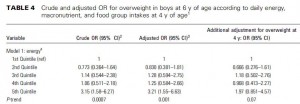Grains, gluten, and kids. And I go WAY overboard on Table 4.
This topic has special relevance because grains provide more calories (31%) than any other food group. And they are probably the most detrimental.
Higher intakes of energy and grain products at 4 years of age are associated with being overweight at 6 years of age (Dubois, Porcherie et al., 2011 Journal of Nutrition)
The Quebec Longitudinal Study of Child Development (QLSCD) assessed food intake and lifestyle variables in ~1,000 Canadian kids born in 1998 for 2 years. The data came primarily from mothers but also daycare attendants when necessary, and their method for assessing food intake was pretty good- “multiple-pass” 24-h dietary recall interviews conducted in the home, and they double-checked by re-questioning a huge subgroup (~50%!, kudos).
Methodological peculiarities:
1) Food groups consisted of
- Grains (e.g., breads, pastas, cereals, rice, etc.)
- Fruits and vegetables
- Dairy
- Meat and alternatives (e.g., meat [duh], lentils, tofu, and peanut butter)
What is the rationale for grouping lentils, tofu, and peanut butter 1) together, and 2) with meat? IOW, data regarding the consumption of “meat and alternatives” will be difficult to interpret.
2) Divisions between underweight, normal weight, and overweight were based on percentiles as opposed to absolute values. For adults, BMI<20 = underweight, 20-25 = normal weight, 25-30 = overweight, and >30 = obese, regardless of the weight of their friends, colleagues, and neighbors. By using percentiles: if the entire cohort is heavier than average, then overweight kids will be classified as normal weight because they are “normal” relative to the rest of the kids in the study, who are heavier than average. So it’s not a debilitating methodological peculiarity, it just changes the definitions with which we are accustomed… so when they start out their results by stating [sic]: “20% of the children were overweight,” it doesn’t mean they have an unusually lean cohort, it actually tells us nothing.
Divide and conquer
Here’s what these kids were eating, in total and broken down by body weight groups:
Heavier kids ate more carbohydrates and less fat, and protein intake was relatively constant. No big surprises, except that none of this reached statistical significance despite being true across all three quintiles… the lack of statistical significance is most likely due to the small sample size, and I suppose we’ve been spoiled lately with studies that included much larger subjects. FTR, the carbs and fat data are probably the most relevant finding WRT feeding your kids.
Table 2 showed macronutrients and total energy, while Table 3 shows the breakdown by food groups (see Methodological Pecularity #2 above).
THIS is troubling. Grain consumption is highly adherent to the guidelines, but the more the guidelines were adhered to, the fatter the kids got. Combined with the amount of calories grains contribute to overall energy intake, this provides a fairly clear explanation for the childhood obesity epidemic. IOW, these data strongly suggest the guidelines are wrong.
The long-awaited Table 4. (did you feel the suspense?)
This table shows the odds for being overweight in increasing quintiles of total calorie intake. The first and second columns show what everyone normally expects: more calories consumed = more chance of being overweight. And it’s highly statistically significant. But here’s the kicker: the third column adjusts for body weight at 4 years of age and the association is abolished. !!! That means being fat at 4 years old was a more important predictor of being fat at 6 years old than calorie intake. Chubby 6 year olds were overweight because they were chubby when they 4 years old, NOT because they ate too much ! Excessive inactivity is ruled out because these data were adjusted for physical activity.
“Eating less and moving more” is not the answer. Nutrition matters. Don’t feed your kids grains, regardless of the guidelines.
calories proper



